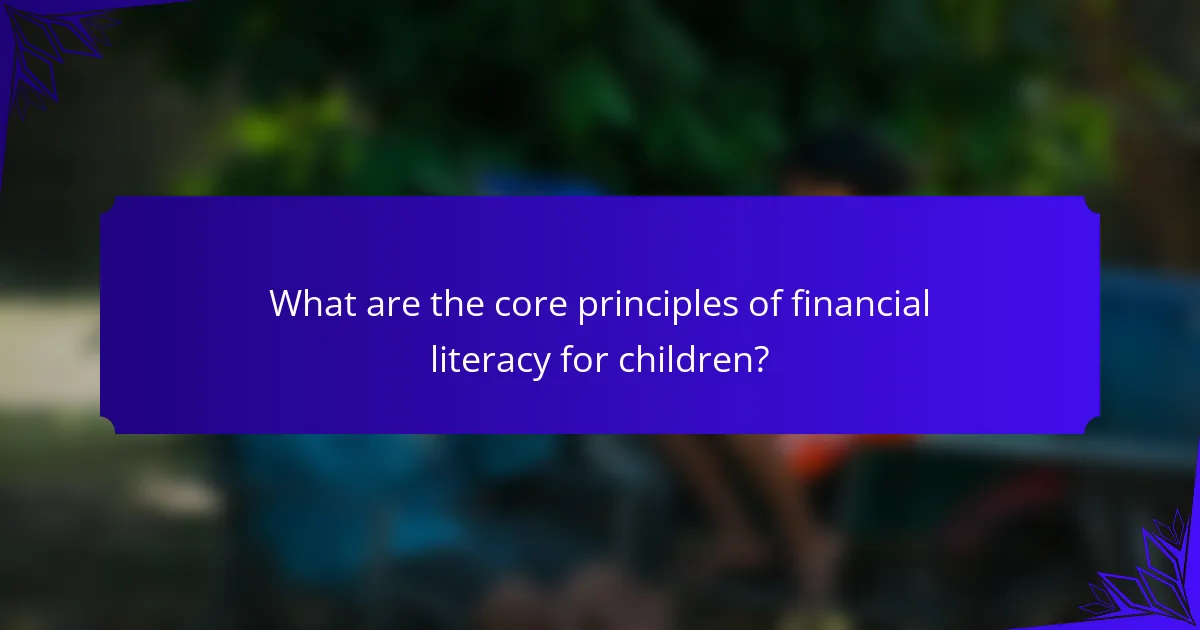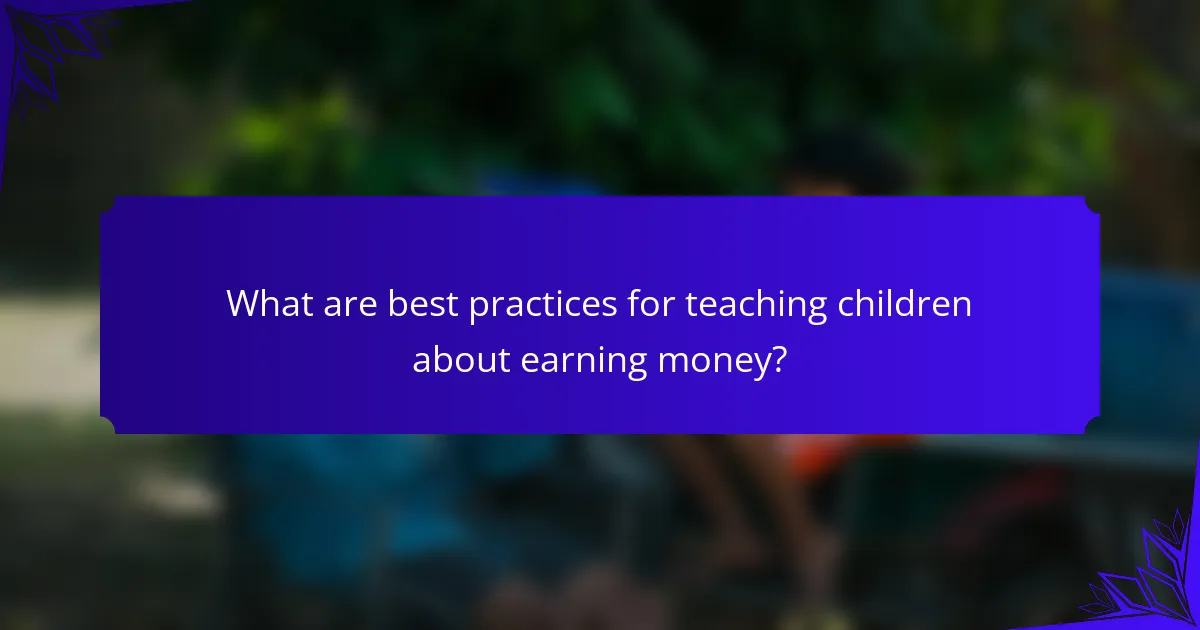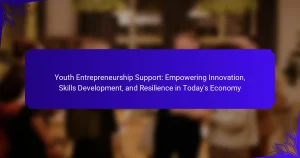Teaching children how to earn money equips them with essential skills for financial independence. This article explores practical skills like cooking and gardening, creative projects such as crafting and online selling, and the importance of financial literacy. By engaging in hands-on experiences and understanding money management, children can develop responsibility and entrepreneurial abilities.

What practical skills can children learn to earn money?
Children can learn various practical skills to earn money, including basic cooking, gardening, and digital skills. These abilities can be monetized through services like baking for events, selling plants, or offering computer assistance. Additionally, creative projects such as crafting and art can lead to income through sales at local markets or online platforms. Financial literacy is crucial; teaching children how to manage their earnings can enhance their understanding of money management and budgeting, fostering long-term financial responsibility.
How can children develop entrepreneurial skills?
Children can develop entrepreneurial skills through hands-on experiences, creative projects, and financial education. Engaging in activities like starting a small business, participating in school clubs, or managing a lemonade stand fosters responsibility and problem-solving.
Practical skills include budgeting, marketing, and customer service. For instance, children can learn to create simple business plans and understand profit margins. Creative projects, such as crafting or baking, can turn into profitable ventures, enhancing their creativity and innovation.
Financial literacy is crucial. Teaching children about saving, investing, and managing money prepares them for future financial decisions. Programs and resources focused on youth entrepreneurship can provide valuable guidance and mentorship, reinforcing these skills.
Encouraging a mindset of resilience and adaptability further supports entrepreneurial growth. As a result, children gain confidence and the ability to navigate challenges, essential traits for future success in any field.
What are effective ways to teach negotiation skills?
Effective ways to teach negotiation skills include role-playing, real-life scenarios, and interactive workshops. These methods engage children and promote practical understanding.
Role-playing allows children to practice negotiation in a safe environment, enhancing their confidence. Real-life scenarios provide context and relevance, making lessons more impactful. Interactive workshops encourage collaboration and peer feedback, fostering a supportive learning atmosphere.
Incorporating these techniques can significantly improve children’s negotiation abilities, preparing them for future financial interactions.
How can children learn basic financial management?
Children can learn basic financial management through hands-on experiences, creative projects, and structured education. Practical skills include budgeting their allowance, saving for desired items, and understanding the value of money. Engaging in creative projects, such as a lemonade stand or selling crafts, teaches them about earning income and managing expenses. Financial literacy programs designed for kids can enhance their understanding of concepts like saving, investing, and responsible spending. These experiences foster a strong foundation for future financial decision-making.
What creative projects can children undertake for income?
Children can undertake various creative projects to earn income, such as crafting, art sales, and digital content creation. Crafting items like handmade jewelry or greeting cards can attract buyers at local markets. Art sales, including paintings or drawings, can be showcased online or in community events. Digital content creation, such as YouTube videos or blog writing, allows children to share their interests while potentially generating revenue through ads or sponsorships. These projects not only provide income but also develop practical skills and financial literacy.
What types of crafts are popular for selling?
Popular crafts for selling include handmade jewelry, custom clothing, home decor items, and personalized gifts. These crafts appeal to a wide audience and often feature unique attributes that enhance their marketability. Handmade jewelry, for instance, offers personalization options, while custom clothing can cater to specific trends. Home decor items can vary in style and material, attracting diverse customer preferences. Personalized gifts stand out due to their emotional value, making them desirable for special occasions.
How can children leverage digital platforms for creative projects?
Children can leverage digital platforms for creative projects by utilizing tools that enhance their skills and promote their work. They can use social media to showcase art, music, or writing, gaining exposure and feedback. Platforms like YouTube and TikTok allow them to create engaging content, building an audience and potential monetization opportunities. Additionally, using websites like Etsy enables children to sell handmade crafts or digital products. These activities foster creativity, improve financial literacy, and teach practical skills essential for future success.

What are the core principles of financial literacy for children?
Financial literacy for children revolves around understanding money management, saving, and investing. Key principles include earning money through chores or small jobs, budgeting to track spending, and distinguishing between needs and wants. Teaching children about saving for goals fosters delayed gratification and financial responsibility. Engaging in creative projects, like selling crafts, enhances entrepreneurial skills while reinforcing practical financial concepts.
Why is understanding money management important for children?
Understanding money management is crucial for children as it builds essential financial literacy skills. Early comprehension of budgeting, saving, and spending fosters responsible financial habits. Children who grasp these concepts are better equipped to handle future financial challenges. Moreover, practical experiences like earning money through chores or creative projects enhance their understanding of value and effort. This foundation supports their transition into adulthood with confidence in managing finances effectively.
What tools can assist children in learning about budgeting?
Children can use various tools to learn about budgeting effectively. Budgeting apps designed for kids, like Greenlight, provide interactive experiences and real-time tracking of expenses. Games such as Monopoly or online simulators can teach financial concepts through play. Workshops or online courses focused on financial literacy can enhance understanding. Additionally, visual aids like charts or budgeting worksheets can help children grasp the importance of managing money.
How can apps help children track their earnings and expenses?
Apps can significantly assist children in tracking their earnings and expenses by providing user-friendly interfaces and engaging features. These tools encourage financial literacy through gamification and interactive elements, making learning about money management enjoyable. Many apps offer features like budgeting tools, savings goals, and expense categorization, which help children understand their financial habits. Additionally, real-time tracking allows children to see the impact of their spending decisions immediately, fostering responsible financial behavior.

What unique opportunities exist for children to earn money today?
Children today can earn money through unique opportunities like online businesses, creative projects, and financial literacy programs. These avenues help develop practical skills while fostering entrepreneurship. Online platforms enable kids to sell crafts or offer services like tutoring. Creative projects, such as art or writing, can be monetized through contests or freelance work. Financial literacy programs teach budgeting and investment basics, empowering children to manage their earnings effectively.
How can children utilize technology for income generation?
Children can utilize technology for income generation through online platforms, creative projects, and skill development. They can engage in activities like content creation, coding, or selling handmade products online. These initiatives foster financial literacy and practical skills, essential for their future. For instance, platforms like YouTube or Etsy allow children to showcase their talents and earn money. Developing skills in areas like graphic design or programming can also lead to freelance opportunities. Encouraging children to explore these avenues promotes entrepreneurship and financial independence.
What are some emerging trends in child entrepreneurship?
Emerging trends in child entrepreneurship focus on digital skills, sustainability, and experiential learning. Children increasingly leverage technology to create online businesses, such as e-commerce or content creation. Sustainability drives interest in eco-friendly products and services. Experiential learning encourages hands-on projects that teach financial literacy and practical skills. These trends foster creativity and independence in young entrepreneurs.

What rare avenues for income can children explore?
Children can explore unique avenues for income through creative projects and practical skills. Options include selling handmade crafts, offering digital services like graphic design, or starting a YouTube channel focused on hobbies. These opportunities foster financial literacy while allowing children to express creativity. Engaging in community projects, such as yard work or tutoring, can also provide valuable experience and income. Such rare avenues not only generate money but also build essential life skills.
How can children engage in community service for financial gain?
Children can engage in community service for financial gain by participating in paid volunteer opportunities or service projects. Many organizations offer stipends or scholarships for young volunteers. For instance, local nonprofits may hire youth for event assistance, while community clean-up initiatives can provide small payments for participation. Additionally, children can create and sell crafts or services related to their community service efforts, enhancing both skill development and financial literacy. This approach fosters a sense of responsibility while also teaching practical financial skills.
What are examples of service-based projects children can initiate?
Children can initiate service-based projects such as pet sitting, lawn mowing, car washing, tutoring, and organizing community clean-ups. These projects develop practical skills and foster financial literacy. Engaging in such activities allows children to understand the value of money while contributing positively to their communities. Each project can be tailored to the child’s interests and abilities, ensuring a unique and rewarding experience.
What unconventional skills can children monetize?
Children can monetize unconventional skills like coding, digital art, content creation, and music production. These skills offer unique opportunities for earning money through platforms that support creative projects. For instance, children can create and sell video games or digital illustrations online. Additionally, they can monetize their talents by starting YouTube channels or offering music lessons. Developing financial literacy alongside these skills is crucial, as it empowers children to manage their earnings effectively.

What are best practices for teaching children about earning money?
Teaching children about earning money involves practical skills, creative projects, and financial literacy. Start by introducing them to basic concepts of money management.
Encourage hands-on experiences, such as setting up a lemonade stand or doing chores for allowance. These activities build entrepreneurial skills and foster responsibility.
Incorporate financial literacy lessons, focusing on saving, budgeting, and understanding value. Use real-life examples to illustrate these concepts.
Finally, celebrate their achievements and progress. Positive reinforcement motivates children to continue learning about money management.
What common mistakes should parents avoid when guiding children?
Parents should avoid being overly controlling, neglecting financial education, and dismissing children’s interests. Encouraging autonomy fosters responsibility. Teaching practical skills enhances financial literacy. Supporting creative projects builds confidence and entrepreneurship. Balancing guidance with freedom promotes healthy decision-making.
How can parents effectively support their children’s financial learning journey?
Parents can support their children’s financial learning by encouraging practical skills and creative projects. Start with age-appropriate tasks like budgeting for a small allowance or saving for a desired toy. Introduce concepts of earning through chores or small jobs, fostering responsibility and work ethic. Utilize games that simulate financial decision-making to make learning engaging. Discuss financial goals and the importance of saving to instill a long-term perspective. Encourage open conversations about money to build confidence and understanding.


